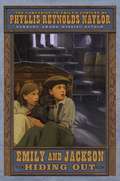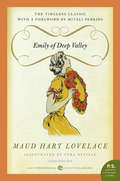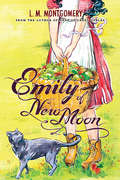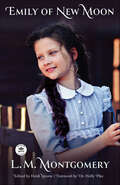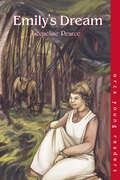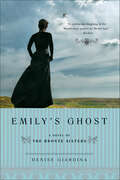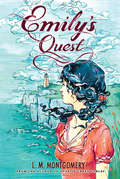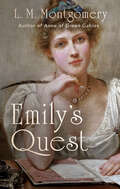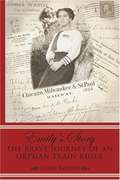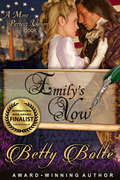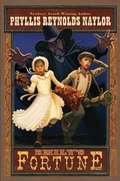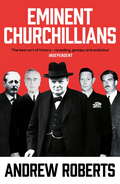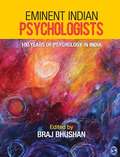- Table View
- List View
Emily Wilde's Compendium of Lost Tales: the enchanting and romantic magical academia phenomenon! (Emily Wilde Series #3)
by Heather Fawcett'A charmingly whimsical delight. . . Five dazzling, gladdening stars' India Holton, author of The Wisteria Society of Lady ScoundrelsThe third instalment in the enchanting light academia Emily Wilde books, about a curmudgeonly scholar of folklore and the fae prince she loves, from Sunday Times bestselling author Heather Fawcett.Emily Wilde has spent her life studying faeries. A renowned dryadologist, she has documented hundreds of species of Folk in her Encyclopaedia of Faeries. Now she is about to embark on her most dangerous academic project yet: studying the inner workings of a faerie realm-as its queen.Along with her former academic rival-now fiancé-the dashing and mercurial Wendell Bambleby, Emily is immediately thrust into the deadly intrigues of Faerie as the two of them seize the throne of Wendell's long-lost kingdom, which Emily finds a beautiful nightmare, filled with scholarly treasures.Emily has been obsessed with faerie stories her entire life, but at first she feels as ill-suited to Faerie as she did to the mortal world-how could an unassuming scholar like herself pass for a queen? Yet there is little time to settle in-Wendell's murderous stepmother has placed a deadly curse upon the land before vanishing without a trace. It will take all of Wendell's magic-and Emily's knowledge of stories-to unravel the mystery before they lose everything they hold dear.Praise for the Emily Wilde books:'Forget dark academia: give me instead this kind of winter-sunshined, sharp-tongued and footnoted academia, full of field trips and grumpy romance' Freya Marske, author of A Marvellous Light'A darkly gorgeous fantasy that sparkles with snow and magic, this book wholly enchanted me' Sangu Mandanna, author of The Very Secret Society of Irregular Witches'A thoroughly charming academic fairy tale, complete with footnotes and a low-key grumpy romance' Guardian'Enchanting in every sense of the word. . . This book is real magic' H. G. Parry, author of The Magician's Daughter'A book so vividly, endlessly enchanting, so crisply assured, so rich and complete and wise and far-reaching in its worldbuilding that you'll walk away half ensorcelled, sure Fawcett found Emily Wilde's journal in some sea-stained trunk' Melissa Albert'The ideal book to curl up with on a chilly winter's evening. . . this book is an absolute delight.' Megan Bannen, author of The Undertaking of Hart and Mercy'I enjoyed every word of this gorgeously written fairy tale featuring a grumpy heroine and an utterly charming love interest' Isabel Ibañez, author of Woven In Moonlight
Emily Wilde's Encyclopaedia of Faeries: the Sunday Times Bestseller (Emily Wilde Series #1)
by Heather Fawcett'A darkly gorgeous fantasy that sparkles with snow and magic, this book wholly enchanted me' Sangu Mandanna, author of The Very Secret Society of Irregular WitchesEnter the world of the hidden folk - and discover the most whimsical, enchanting and heart-warming tale you'll read this year, featuring the intrepid Emily Wilde. . .Emily Wilde is good at many things: she is the foremost expert on the study of faeries; she is a genius scholar and a meticulous researcher who is writing the world's first encylopaedia of faerie lore. But Emily Wilde is not good at people So when she arrives in the hardscrabble village of Hrafnsvik, Emily has no intention of befriending the gruff townsfolk. Nor does she care to spend time with another new arrival: her dashing and insufferably handsome academic rival Wendell Bambleby But as Emily gets closer to uncovering the secrets of the Hidden Ones - the most elusive of all faeries - she also finds herself on the trail of another mystery: who is Wendell Bambleby, and what does he really want? To find the answer, she'll have to unlock the greatest mystery of all - her own heart.'Forget dark academia: give me instead this kind of winter-sunshined, sharp-tongued and footnoted academia, full of field trips and grumpy romance' Freya Marske, author of A Marvellous Light'Enchanting in every sense of the word. . . This book is real magic' H. G. Parry, author of The Unlikely Escape of Uriah Heep'A book so vividly, endlessly enchanting, so crisply assured, so rich and complete and wise and far-reaching in its worldbuilding that you'll walk away half ensorcelled, sure Fawcett found Emily Wilde's journal in some sea-stained trunk' Melissa Albert'The ideal book to curl up with on a chilly winter's evening. . . this book is an absolute delight.' Megan Bannen, author of The Undertaking of Hart and Mercy'A charmingly whimsical delight. . . Five dazzling, gladdening stars' India Holton, author of The Wisteria Society of Lady Scoundrels'I enjoyed every word of this gorgeously written fairy tale featuring a grumpy heroine and an utterly charming love interest' Isabel Ibañez, author of Woven In Moonlight
Emily Wilde's Encyclopaedia of Faeries: the cosy and heart-warming Sunday Times Bestseller (Emily Wilde Series #1)
by Heather FawcettTHE SUNDAY TIMES BESTSELLER'A darkly gorgeous fantasy that sparkles with snow and magic, this book wholly enchanted me' Sangu Mandanna, author of The Very Secret Society of Irregular WitchesEnter the world of the hidden folk - and discover the most whimsical, enchanting and heart-warming tale you'll read this year, featuring the intrepid Emily Wilde. . .Emily Wilde is good at many things: she is the foremost expert on the study of faeries; she is a genius scholar and a meticulous researcher who is writing the world's first encylopaedia of faerie lore. But Emily Wilde is not good at people So when she arrives in the hardscrabble village of Hrafnsvik, Emily has no intention of befriending the gruff townsfolk. Nor does she care to spend time with another new arrival: her dashing and insufferably handsome academic rival Wendell Bambleby But as Emily gets closer to uncovering the secrets of the Hidden Ones - the most elusive of all faeries - she also finds herself on the trail of another mystery: who is Wendell Bambleby, and what does he really want? To find the answer, she'll have to unlock the greatest mystery of all - her own heart.'Forget dark academia: give me instead this kind of winter-sunshined, sharp-tongued and footnoted academia, full of field trips and grumpy romance' Freya Marske, author of A Marvellous Light'A thoroughly charming academic fairy tale, complete with footnotes and a low-key grumpy romance' Guardian'Enchanting in every sense of the word. . . This book is real magic' H. G. Parry, author of The Unlikely Escape of Uriah Heep'A book so vividly, endlessly enchanting, so crisply assured, so rich and complete and wise and far-reaching in its worldbuilding that you'll walk away half ensorcelled, sure Fawcett found Emily Wilde's journal in some sea-stained trunk' Melissa Albert'The ideal book to curl up with on a chilly winter's evening. . . this book is an absolute delight.' Megan Bannen, author of The Undertaking of Hart and Mercy'A charmingly whimsical delight. . . Five dazzling, gladdening stars' India Holton, author of The Wisteria Society of Lady Scoundrels'I enjoyed every word of this gorgeously written fairy tale featuring a grumpy heroine and an utterly charming love interest' Isabel Ibañez, author of Woven In Moonlight
Emily Wilde's Map of the Otherlands (Emily Wilde Series #2)
by Heather Fawcett'Forget dark academia: give me instead this kind of winter-sunshined, sharp-tongued and footnoted academia, full of field trips and grumpy romance' Freya Marske, author of A Marvellous LightAn intrepid professor must uncover faerie secrets in the delightful and heart-warming second instalment of the Sunday Times bestselling Emily Wilde series.Emily Wilde is a genius scholar of faerie folklore, and has catalogued many secrets of the Hidden Folk in her encyclopaedia with her infuriatingly charming fellow scholar, Wendell Bambleby, by her side.But Bambleby is more than just a brilliant and unbearably handsome scholar. He's an exiled faerie king on the run from his murderous mother, in search of a door back to his realm. By lucky happenstance, Emily's new project, a map of the realms of faerie, will take them on an adventure to the picturesque Austrian Alps, where Emily believes they may find the door to Bambleby's realm, and the key to freeing him from his family's dark plans. But with new friendships for the prickly Emily to navigate and dangerous Folk lurking in every forest and hollow, Emily must unravel the mysterious workings of faerie doors, and of her own heart. Praise for this series:'A darkly gorgeous fantasy that sparkles with snow and magic, this book wholly enchanted me' Sangu Mandanna, author of The Very Secret Society of Irregular Witches'A thoroughly charming academic fairy tale, complete with footnotes and a low-key grumpy romance' Guardian'Enchanting in every sense of the word. . . This book is real magic' H. G. Parry, author of The Unlikely Escape of Uriah Heep'A book so vividly, endlessly enchanting, so crisply assured, so rich and complete and wise and far-reaching in its worldbuilding that you'll walk away half ensorcelled, sure Fawcett found Emily Wilde's journal in some sea-stained trunk' Melissa Albert'The ideal book to curl up with on a chilly winter's evening. . . this book is an absolute delight.' Megan Bannen, author of The Undertaking of Hart and Mercy'A charmingly whimsical delight. . . Five dazzling, gladdening stars' India Holton, author of The Wisteria Society of Lady Scoundrels'I enjoyed every word of this gorgeously written fairy tale featuring a grumpy heroine and an utterly charming love interest' Isabel Ibañez, author of Woven In Moonlight
Emily Wilde's Map of the Otherlands (Emily Wilde Series #2)
by Heather Fawcett'Forget dark academia: give me instead this kind of winter-sunshined, sharp-tongued and footnoted academia, full of field trips and grumpy romance' Freya Marske, author of A Marvellous LightAn intrepid professor must uncover faerie secrets in the delightful and heart-warming second instalment of the Sunday Times bestselling Emily Wilde series.Emily Wilde is a genius scholar of faerie folklore, and has catalogued many secrets of the Hidden Folk in her encyclopaedia with her infuriatingly charming fellow scholar, Wendell Bambleby, by her side.But Bambleby is more than just a brilliant and unbearably handsome scholar. He's an exiled faerie king on the run from his murderous mother, in search of a door back to his realm. By lucky happenstance, Emily's new project, a map of the realms of faerie, will take them on an adventure to the picturesque Austrian Alps, where Emily believes they may find the door to Bambleby's realm, and the key to freeing him from his family's dark plans. But with new friendships for the prickly Emily to navigate and dangerous Folk lurking in every forest and hollow, Emily must unravel the mysterious workings of faerie doors, and of her own heart. Praise for this series:'A darkly gorgeous fantasy that sparkles with snow and magic, this book wholly enchanted me' Sangu Mandanna, author of The Very Secret Society of Irregular Witches'A thoroughly charming academic fairy tale, complete with footnotes and a low-key grumpy romance' Guardian'Enchanting in every sense of the word. . . This book is real magic' H. G. Parry, author of The Unlikely Escape of Uriah Heep'A book so vividly, endlessly enchanting, so crisply assured, so rich and complete and wise and far-reaching in its worldbuilding that you'll walk away half ensorcelled, sure Fawcett found Emily Wilde's journal in some sea-stained trunk' Melissa Albert'The ideal book to curl up with on a chilly winter's evening. . . this book is an absolute delight.' Megan Bannen, author of The Undertaking of Hart and Mercy'A charmingly whimsical delight. . . Five dazzling, gladdening stars' India Holton, author of The Wisteria Society of Lady Scoundrels'I enjoyed every word of this gorgeously written fairy tale featuring a grumpy heroine and an utterly charming love interest' Isabel Ibañez, author of Woven In Moonlight
Emily and Jackson Hiding Out (Emily #2)
by Phyllis Reynolds NaylorEmily Wiggins is thrilled that she and her orphan friend Jackson have escaped the clutches of the Child-Catching Services and Emily's villainous uncle Victor. Emily and Jackson are now living happily with her loving aunt Hilda. But just a mighty mouth minute! Someone's snooping around for an orphan child on the run! He knows Jackson is hiding nearby and aims to get a reward for snatching him and sending him to work at a mill. What in leapin' livers should Jackson do? And Emily can't rest easy either, since some sort of creature is coming to their gate when Jackson and Emily are home alone. What in simmering succotash is that moving pile of dirt? Is it a heap of black rags, is it a dusty tumbleweed, no it's . . . Now what in shaking shivers will happen next?
Emily and the Dark Angel
by Jo BeverleyNew York Times bestselling author Jo Beverley "brings the Regency Period to life. " (Joan Hammond) Emily Grantwich lives quietly with her crippled father and eccentric aunt, managing the family's land, until the fateful day she walks down the main street of Melton Mowbray and is showered with Poudre de Violettes, thrown by a lady of loose morals at the handsomest man Emily has ever seen. He is Piers Verderan, known by many as the Dark Angel. His friends lay the blame for his scandalous ways on his troubled past. No decent woman should be seen in his company, but Emily must dutifully manage her father's estate-which Verderan's land adjoins. Soon Emily learns that the Dark Angel is very dangerous, especially to her sanity and her heart. . . .
Emily of Deep Valley
by Maud Hart LovelaceEmily Webster, an orphan living with her grandfather, is not like the other girls her age in Deep Valley, Minnesota. After graduation, she longs to join the Crowd and go off to college-but she can't leave her grandfather alone at home. Resigning herself to a "lost winter," Emily nonetheless throws herself into a new program of study and a growing interest in the local Syrian community, and when she meets a handsome new teacher at the high school, Emily gains more than she ever dreamed possible. Maud Hart Lovelace's only young adult stand-alone novel, Emily of Deep Valley is considered by fans of her beloved Betsy-Tacy series to be one of the author's finest works.
Emily of New Moon
by L. M. Montgomery"I love Emily."--Madeleine L'Engle Finding a Place to Belong Orphaned after her father's death, thirteen-year-old Emily Starr is sent to live with her snobbish relatives at New Moon Farm. At first, Emily's miserable under all the rules from her stern Aunt Elizabeth. And being the new girl at school is not easy. At least New Moon provides plenty of material for the short stories she loves to write. With her quick wit and lively imagination, it's not long before she finds friends in tomboy Ilse and artist Teddy. And even though Emily can't seem to stay out of trouble for long, New Moon may just start to feel like home after all... This new edition of a classic favorite restores the original, unabridged text and includes an all-new, exclusive introduction with special memories from L.M. Montgomery's granddaughter. What Readers are Saying: "For the millions of girls who love Anne of Green Gables, this series provides a glimpse at another girl who is just a little different." "Although I love Anne of Green Gables, Emily of New Moon is my favorite creation of Lucy Maud Montgomery."
Emily of New Moon
by L. M. MontgomeryA lost classic by the author of?Anne of Green Gables,?Emily of New Moon?is a coming-of-age story about newly orphaned Emily Byrd Starr, who deals with the loss of her beloved father as she tries to adjust to life at old-fashioned New Moon farm with her aunts and cousin. Emily, a budding writer with a mysterious sense of the otherworldly, makes quick friends in her new home and lands in more than her share of scrapes along the way. But she remains haunted by one thing: the scandalous mystery of what happened to her best friend's mother. Will Emily thrive under the austere rule of her Aunt Elizabeth? What will happen when she visits her notorious Great-Aunt, Nancy Priest—rumored to be a witch? And will she learn what happened to the missing Beatrice Burnley—and at what cost? With a new foreword by esteemed scholar Dr. E. Holly Pike, an expert with regard to L.M. Montgomery's career and works, this new edition will delight fans of all ages and introduce them to a heroine that the author felt closer to than her most famous character,?Anne of Green Gables
Emily's Dream (Orca Young Readers #Sequel To Discovering Emily)
by Jacqueline PearceIn the sequel to Discovering Emily, Emily Carr is determined to become an artist. Emily's parents have died, and she and her siblings are ruled by the iron-willed eldest, Dede. Dede is more concerned with decorum than with ridiculous dreams and is not averse to punishing Emily severely. In the face of such resistance, and in the conservative climate of nineteenth-century Victoria, Emily must find a way to make her dream come true.
Emily's Ghost: A Novel of the Brontë Sisters
by Denise Giardina"Denise Giardina’s extraordinary gift for conjuring voices of the past has never been more bewitchingly deployed than here in Emily’s Ghost—a romance so tormentedly devoted to its struggle toward truth that Brontë herself would be proud of it." —Madison Smartt BellEnigmatic, intelligent, and fiercely independent, Emily Brontë refuses to bow to the conventions of her day. She is distrustful of marriage, prefers freedom above all else, and walks alone at night on the moors above the isolated rural village of Haworth. But Emily’s life is turned upside down by the arrival of an idealistic clergyman named William Weightman. A heart-wrenching love story, Emily’s Ghost plumbs the depths of faith, longing, and romantic solitude.
Emily's House
by Amy Belding BrownShe was Emily Dickinson&’s maid, her confidante, her betrayer… and the savior of her legacy. An evocative new novel about Emily Dickinson's longtime maid, Irish immigrant Margaret Maher, whose bond with the poet ensured Dickinson's work would live on, from the USA Today bestselling author of Flight of the Sparrow, Amy Belding Brown. Massachusetts, 1869. Margaret Maher has never been one to settle down. At twenty-seven, she's never met a man who has tempted her enough to relinquish her independence to a matrimonial fate, and she hasn't stayed in one place for long since her family fled the potato famine a decade ago.When Maggie accepts a temporary position at the illustrious Dickinson family home in Amherst, it's only to save money for her upcoming trip West to join her brothers in California. Maggie never imagines she will form a life-altering friendship with the eccentric, brilliant Miss Emily or that she'll stay at the Homestead for the next thirty years. In this richly drawn novel, Amy Belding Brown explores what it is to be an outsider looking in, and she sheds light on one of Dickinson's closest confidantes—perhaps the person who knew the mysterious poet best—whose quiet act changed history and continues to influence literature to this very day.
Emily's Quest
by L. M. Montgomery"I love Emily."-Madeleine L'Engle Will Emily's Dreams Ever Come True? High school is over and Emily Starr is ready to find her destiny...but she's not quite ready to leave the safety of New Moon farm. She knows that she doesn't need New York City or some other exotic locale to help her become a famous writer. But as all of Emily's friends begin moving away to pursue their own aspirations in exciting places, she wonders if she's made the right choice. After suffering through a devastating illness, receiving rejection notices from multiple publishers, and nearly losing Teddy, her childhood sweetheart, Emily realizes that her quest for love, acceptance, and happiness is far from over. This new edition lovingly restores the original, unabridged text and includes an all-new, exclusive introduction with special memories from L.M. Montgomery's granddaughter. What Readers Are Saying: "Emily's Quest is my favorite of the Emily books (probably of all her books), and a wonderful real for any romantic like me." "Wonderful. As with all the Montgomery books, the beauty of the world captures you. Emily's Quest is a brilliant end to a most charming series of books." "Emily's Quest is truly a wonderful ending to one of the best stories ever written."
Emily's Quest: Large Print (The Emily Trilogy)
by L. M. MontgomeryA young woman on the brink of adulthood comes to terms with love and her ambitions in this series finale by the beloved author of Anne of Green Gables. After graduating high school, seventeen-year-old Emily Starr is ready to pursue her destiny as a great writer from the comfort of her hometown, New Moon. Meanwhile, her friends and her childhood sweetheart, Teddy Kent, are headed elsewhere to chase their own aspirations. Feeling rejected by friends and her beloved, Emily throws herself into completing her novel, only to have it rejected by publishers. After suffering from a life-threatening illness, Emily is forced to reconsider her options, what it means to be a writer, and pursuing a married life with a man she doesn’t truly love . . .
Emily's Secret: A Writer... A Love Story... A Curse... A Diary... A Secret...
by Jill JonesAn American scholar is out to solve the mystery of Emily Brontë’s death, only to discover a chance at love in this “delightful and visionary tale” (Romantic Times). American professor Alex Hightower isn’t looking for love when he travels to the small English village of Haworth, once home of the legendary Brontë sisters. An Emily Brontë scholar, Alex is troubled by her tragic early death, and determined to investigate his theory that she may have taken her own life following a turbulent affair. Alex’s research leads him not only to an old letter and a rumored family curse, but to the beautiful, mysterious artist Selena Wood. Selena has her own ties to the author’s legacy . . . and awakens a desire in Alex that he can’t deny. In this enchanting debut novel, “the history of Emily’s secret romance becomes entwined with that of Alex and [Selena]” (Publishers Weekly).
Emily's Story: The Brave Journey of an Orphan Train Rider
by Clark KidderIt seems incomprehensible that there was a time in America s not-so-distant past that nearly 200,000 children could be loaded on trains in large cities on our East Coast, sent to the rural Midwest, and presented for the picking to anyone who expressed an interest in them. That s exactly what happened between the years 1854 and 1930. The primitive social experiment became known as placing out, and had its origins in a New York City organization founded by Charles Loring Brace called the Children s Aid Society. The Society gathered up orphans, half-orphans, and abandoned children from streets and orphanages, and placed them on what are now referred to as Orphan Trains. It was Brace s belief that there was always room for one more at a farmer s table. The stories of the individual children involved in this great migration of little emigrants have nearly all been lost in the attic of American history. In this book, the author tells the true story of his paternal grandmother, the late Emily (Reese) Kidder, who, at the tender age of fourteen, became one of the aforementioned children who rode an Orphan Train. In 1906, Emily was plucked from the Elizabeth Home for Girls, operated by the Children's Aid Society, and placed on a train, along with eight other children, bound for Hopkinton, Iowa. Emily's journey, as it turned out, was only just beginning. Life had many lessons in store for her lessons that would involve overcoming adversity, of perseverance, love, and great loss. Emily's story is told through the use of primary material, oral history, interviews, and historical photographs. It is a tribute to the human spirit of an extraordinary young girl who became a woman a woman to whom the heartfelt phrase there s no place like home, had a very profound meaning.
Emily's Vow (A More Perfect Union Series #1)
by Betty BolteEmily Sullivan's greatest fear is dying in childbirth, as did her twin sister and their mother. Then she's thrown in a loyalist prison for her privateering father's raids on the British, and her accuser--a former beau--promises to recant if she will marry him.Frank Thomson always loved Emily despite her refusal to return his affections. A patriot spy posing as a loyalist officer, when Frank learns of Emily's plight, he challenges her accuser to a duel.Freed from prison, Emily ponders returning the affections of her rescuer--the only man she's ever loved and who married her twin to save the Sullivan family's reputation. But Frank cannot afford to be discovered. For the sake of young America, he must deliver his secrets.AWARDS:International Book Awards, FinalistA MORE PERFECT UNION SERIES, in order:Emily's VowAmy's ChoiceSamantha's Secret
Emily, la esposa de conveniencia (Trilogía Hermanas Davenport #Volumen 3)
by Verónica MengualVuelven las hermanas Davenport con la historia de Emily. ¿Se puede amar sin apenas conocerse? Una simple ojeada y la pequeña de las Davenport sabe que él es lo que siempre quiso. Lady Emily, como hija de un conde sin herederos, aceptó la voluntad de su padre para casarse con un extraño que heredará la finca familiar, pues quiere salvar a su familia de quedarse en la calle sin nada. Él es el nuevo conde de Dorset, un hombre fiero, arrogante y que no está dispuesto a sucumbir a las bajas pasiones que la joven despierta en él. Es por ello por lo que le abrirá la puerta para que escape; no obstante, si ella no se marcha, Dorset no la dejará marchar jamás. ¿Podrá la dulce Emily lidiar con semejante pirata?
Emily: gripping romantic saga from the Sunday Times bestseller
by Val WoodAn unforgettable story of loss, love and betrayal from the Sunday Times bestselling author of The Lonely Wife.Emily was only five years old when she was sent away from her family to go and live with old Granny Edwards. A loving and hard-working child, she goes into service when she is twelve at the house of Roger Francis, whose connections with Emily's own family prove to be closer than she could ever have guessed. Roger's daughter Deborah takes a great fancy to Emily, and when Emily has moved to another household in Hull she finds that her new employer's son Hugo is to marry Deborah. But Hugo, too, has taken a fancy to Emily, and dishonours and then betrays her to such an extent that she is imprisoned, tried and deported to Australia. But just when her fortunes seem to be at their lowest, Emily is reunited with the one man who can save her from her miserable existence and bring her wealth and happiness. Praise for Val Wood:'Wonderfully fully-fleshed characters are the mainstay of [Val Wood's] stories' Peterborough TelegraphA gripping saga' The People's Friend
Emily’s Fortune
by Phyllis Reynolds NaylorFrom a Newbery Award-winning author comes a witty tale of the Wild West filled with comical cliffhangers and featuring a cast of plucky orphans and dastardly villains.
Eminent Churchillians
by Andrew RobertsA controversial account of the Churchill years by a bestselling historian.'The best sort of history - revealing, gossipy and acidulous' OBSERVERThis highly praised book by the Wolfson History Prize-winning author of SALISBURY tackles six aspects of Churchilliana and uncovers a plethora of disturbing facts about wartime and post-war Britain.His revelations include: - The case for the impeachment of Lord Mountbatten- The Nazi sympathies of Sir Arthur Bryant, hitherto considered a 'patriotic historian'- The British establishment's doubt about Churchill's role after Dunkirk- The appeasement of the trade unions in Churchill's Indian summer- The inside story of black immigration in the early 1950s- The anti-Churchill stance adopted by the Royal Family in 1940
Eminent Churchillians
by Andrew RobertsA controversial account of the Churchill years by a bestselling historian.'The best sort of history - revealing, gossipy and acidulous' OBSERVERThis highly praised book by the Wolfson History Prize-winning author of SALISBURY tackles six aspects of Churchilliana and uncovers a plethora of disturbing facts about wartime and post-war Britain.His revelations include: - The case for the impeachment of Lord Mountbatten- The Nazi sympathies of Sir Arthur Bryant, hitherto considered a 'patriotic historian'- The British establishment's doubt about Churchill's role after Dunkirk- The appeasement of the trade unions in Churchill's Indian summer- The inside story of black immigration in the early 1950s- The anti-Churchill stance adopted by the Royal Family in 1940
Eminent Domain
by Ilya Somin Iljoong Kim Hojun LeeIn 2005, the Supreme Court ruled that the city of New London, Connecticut, could condemn fifteen residential properties in order to transfer them to a new private owner. Although the Fifth Amendment only permits the taking of private property for "public use," the Court ruled that the transfer of condemned land to private parties for "economic development" is permitted by the Constitution--even if the government cannot prove that the expected development will ever actually happen. The Court's decision in Kelo v. City of New London empowered the grasping hand of the state at the expense of the invisible hand of the market. In this detailed study of one of the most controversial Supreme Court cases in modern times, Ilya Somin argues that Kelo was a grave error. Economic development and "blight" condemnations are unconstitutional under both originalist and most "living constitution" theories of legal interpretation. They also victimize the poor and the politically weak for the benefit of powerful interest groups and often destroy more economic value than they create. Kelo itself exemplifies these patterns. The residents targeted for condemnation lacked the influence needed to combat the formidable government and corporate interests arrayed against them. Moreover, the city's poorly conceived development plan ultimately failed: the condemned land lies empty to this day, occupied only by feral cats. The Supreme Court's unpopular ruling triggered an unprecedented political reaction, with forty-five states passing new laws intended to limit the use of eminent domain. But many of the new laws impose few or no genuine constraints on takings. The Kelo backlash led to significant progress, but not nearly as much as it may have seemed. Despite its outcome, the closely divided 5-4 ruling shattered what many believed to be a consensus that virtually any condemnation qualifies as a public use under the Fifth Amendment. It also showed that there is widespread public opposition to eminent domain abuse. With controversy over takings sure to continue, The Grasping Hand offers the first book-length analysis of Kelo by a legal scholar, alongside a broader history of the dispute over public use and eminent domain and an evaluation of options for reform.
Eminent Indian Psychologists: 100 years of Psychology in India
by Professor Braj BhushanEminent Indian Psychologists: 100 years of Psychology in India presents a chronology of important research and noteworthy events in the field of Psychology in the last hundred years. Psychology as a discipline was first introduced in this country in 1916–in the University of Calcutta. In 2016 the hundred-year milestone was reached. Prominent psychologists of our times have documented this hundred-year journey and its highlights in this book. The book also chronicles the lives and work of eminent Indian psychologists, who helped make Psychology practice and research what it is today. Their contributions – research articles, monographs, books, etc.–have been listed and summarized. Some of this scholarship influenced psychologists all over the world. The book takes a retrospective look at the development of Psychology and discusses the contribution of Indian institutions and experts.





